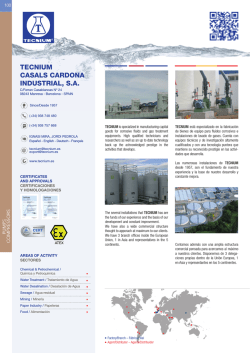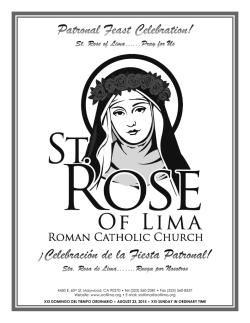
Descargar PDF
CARMEN PARRA Nace en la Ciudad de México en 1944. Es hija del arquitecto Manuel Parra y de María del Carmen Rodríguez Peña. Artista multidisciplinaria, polígrafa, de 1959 a 1964 comenzó su formación artística estudiando teatro en la Escuela Nacional Preparatoria número 5 de la unam e inició sus estudios de antropología social en la Escuela Nacional de Antropología e Historia en la Ciudad de México. The daughter of the architect Manuel Parra and María del Carmen Rodríguez Peña, was born in Mexico City in 1944. A multidisciplinary artist and polymath, her artistic education began in 1959-1964 at the Universidad Nacional de México’s (unam) Escuela Preparatoria No. 5, where she studied theater, and then at Mexico City’s Escuela Nacional de Antropología e Historia. Ciudadana del mundo, ávida de conocer todas las expresiones artísticas, estudió diseño gráfico para el cine en el Royal College of Arts de Londres, pintura en la Academia de Bellas Artes de Roma, en 1964 y música en el Instituto Villalobos de Río de Janeiro. Finalmente regresa a México y concluye sus estudios en La Esmeralda. Estas experiencias fueron el parteaguas de su trayectoria creativa. A citizen of the world and an avid student of every form of artistic expression, she studied graphic design for film at London’s Royal College of Arts, painting at Rome’s Accademia di Belle Arti and music at Rio de Janeiro’s Instituto Villalobos, finally returning to Mexico to conclude her studies at La Esmeralda. These experiences were the starting point for her creative pursuits. A lo largo de su incesante actividad plástica, Carmen Parra ha generado una hermandad con los artistas novohispanos para rescatar su tiempo, su iconografía —altares, espacios arquitectónicos, ángeles, arcángeles, águilas, mariposas y flores cohabitan en su obra. El mundo de El Aire puebla su sueños. A través de su pincel y de su inagotable imaginación transcribe su experiencia, creando un lenguaje propio. Para Carmen Parra, las raíces de México son sus propias alas; se declara veedora de la Nación. Throughout her busy artistic career, Carmen Parra has felt a close kinship to colonial-era artists, finding inspiration in their time and their iconography — altars, baroque architecture, angels, archangels, eagles, butterflies and flowers abound in her work. The world of El Aire populates her dreams. Her brush and her inexhaustible imagination embody her experiences and create their own language. Declaring herself to be the nation’s witness, Mexico’s roots are Carmen Parra’s wings. LA CATEDRAL DE MÉXICO THE MEXICO CITY CATHEDRAL Carmen Parra recrea la Catedral como ésta, a su vez, recreó nuestra cultura –es decir nuestra historia, nuestras creencias, nuestra ideología, nuestros rasgos nacionales– y la concentró en un edificio donde el tiempo, en vez de transcurrir, persiste y se acumula. GONZALO CELORIO Carmen Parra recreates the Cathedral just as the Cathedral, in turn, recreates our culture – in other words, our history, our beliefs, our ideology, our national characteristics – concentrating them in a building where, instead of passing, time persists and accumulates. EN ALAS DE LA PALABRA ON THE WINGS OF THE WORD Ángeles andróginos con muslos de una rotunda morbidez inquietante, santas que quiebran la cintura mientras miran al cielo en un éxtasis más terrenal que místico, santos guerreros que sonríen embelesados como adolescentes en transe erótico, padres del desierto que parecen recordar la delicia de una carne que los ha abandonado para siempre, todos cantan al santísimo en una celebración celestial anclada, en el siempre renovado milagro del mundo. Á LVA RO M U T I S Androgynous angels whose muscles have an emphatic and disturbing softness, saints who turn their backs as they gaze at the heavens in an ecstasy that is more earthly than mystic, holy warriors who bewitchingly smile like adolescents in an erotic trance, desert fathers who seem to remember the pleasures of the flesh that have abandoned them forever, all of them praising the Most High in a celestial celebration anchored in the perennial renewal of the miracle. VUELO Y VIENTO WIND AND FLIGHT Si miro, cierto, veo las formas tan puras del pájaro, y si escucho, oigo el zumbido de las alas al emprender el vuelo, oigo los trinos, los gorjeos, los gorgoritos, los arrullos, los sonidos agudos y los gritos roncos, en fin la orquesta entera de la celebración del mundo. Sí, no temo escribirlo, más allá de todas las desgracias terrestres, la Tierra sigue siendo un lugar hechizante. Nunca agradeceremos bastante a Carmen Parra darnos la prueba. VILMA FUENTES If I look, I can see the pure forms of a bird, and if I listen, I can hear the sound of wings in flight, I hear trills, chirps, warbles, coos, shrill sounds, hoarse cries and all of the rest of the elements making up the orchestra of worldly celebration. I’m not afraid to say it, but beyond all earthly catastrophes, the world continues to be an enchanting place. We will never be able to thank Carmen Parra enough for proving it to us. Carmen Parra recoge en su pintura todo lo que las mariposas han representado para la cultura y por ende, lo que a ellas nos une. En sus cuadros, nos restituye esa figura, esa huella o dibujo con la que empiezan todas las mitologías y que hace que algo se vuelva atávico para el espíritu humano. [...] El motivo de la Monarca es una alegoría para leer el mundo y reflexionar sobre la relación entre el ser humano y la naturaleza. La metamorfosis de la mariposa significa la aspiración del ser humano a encontrar siempre la luz en todos los sentidos, así como la posibilidad de renacer con nuevas utopías o cosmovisiones. ALICIA GARCÍA BERGUA Carmen Parra’s paintings encompass all the meanings that butterflies have represented in our culture and, therefore, everything that draws us to them. In her paintings, she restores that figure, that mark or drawing with which all mythologies begin and which make things become atavistic for the human spirit. […] The motif of the Monarch butterfly is an allegory that allows us to understand the world and reflect on the relationship between humans and nature. The metamorphosis of the butterfly signifies the human aspiration to always seek the light, as well as the possibility of being reborn in new utopias or with new worldviews. CABALLOS Y TOROS HORSES AND BULLS El lujo deslumbrante de los colores, el boato de las texturas, la claridad de la composición, todo eso dice riqueza, poder, refinamiento, esplendor. Porque hay algo de joyería en estos cuadros, se diría que están pintados con oro, plata y piedras preciosas transformadas en colores. HUGO HIRIART The dazzling luxury of colors, the ostentation of textures, the clarity of composition, all of this says richness, power, refinement, splendor. There is something in these paintings reminiscent of jewelry – they could be said to be painted with gold, silver and precious stones that have been transformed into colors. POLIGRAFÍA POLYMATHY Estos dibujos parecen estar hechos de la misma sustancia de que están hechos los sueños, para rescatar para la pintura una cualidad ya consagrada por el teatro, y no la invoco en vano para invitar al curioso espectador a presenciar este drama óptico en el que revive el sueño de la torre sumergida –especialmente en el dibujo compuesto en forma de scroll o kakemono– que resumen con una consecuencia inflexible, un sueño concebido para ser representado como un drama de la imaginación en la escena del papel vacío. S A LVA D O R E L I ZO N D O These drawings seem to be made of the same substance as dreams. They restore a quality to painting that has already been consecrated by the theater, and I don’t make this comparison in vain. I invite spectators to witness this optical drama that revives the dream of the sunken tower – especially in the drawing composed on a scroll or kakemono – which inevitably encapsulates a dream conceived to be represented as a drama of the imagination on the stage of the empty page. EL AIRE CENTRO DE ARTE EL AIRE ART CENTER EN UNA TRINCHERA CULTURAL El Aire, Centro de Arte, A.C., es una casa con historia, pues perteneció al artista Miguel Covarrubias quien se la heredó al arquitecto Luis Barragán, amigo de la familia. El Aire es una trinchera cultural para defender a nuestra familia artística: descendientes de artistas con una posición romántica, anárquica, jesuítica y surrealista que es difícil preservar en este mundo globalizado. Nuestro bagaje cultural es la historia del arte en México: hijos de Vasconcelos y del movimiento de la ruptura. En el naufragio actual de las corrientes internacionales, lanzamos un ancla en El Aire, Centro de Arte, para organizar, transformar y hacer una reflexión sobre nuestro legado y nuestro propio trabajo en este vértigo de imágenes del mundo contemporáneo. Nuestro motor tiene como base ética la bondad, una abstracción que se convierte en energía positiva; y el amor, que es la fuerza para hacer todo nuestro trabajo y nuestros proyectos con la familia, los amigos, los clientes y todos los que nos rodean. Defenderse atrincherado y resistir para poder ser libres y crear un lenguaje que sale de nuestro propio momento: el grito que nos tocó asumir en esta convulsa historia, la cual aún no podemos ver pues todavía está muy cerca. Parte fundamental de nuestra labor en este centro cultural, es el desarrollo de proyectos sociales, altruistas, de rescate del patrimonio histórico y natural. El Aire, Centro de Arte surge en 1997 con la finalidad de organizar a los ParraGironella. Cuenta con una galería, un espacio exterior que brinda la posibilidad de exhibir esculturas, instalaciones y otras manifestaciones del arte contemporáneo, así como la biblioteca, Esto es Gallo, y un archivo conformado por un importante acervo fotográfico. IN THE CULTURAL FORTRESS The El Aire Art Center is located in a historic building that once belonged to the artist Miguel Covarrubias, who himself inherited it from the architect Luis Barragán, a friend of the family. El Aire is a cultural fortress designed to protect our artistic family: descendants of artists with a romantic, anarchic, Jesuitical and surrealistic position that is difficult to preserve in this globalized world. Our cultural grounding is the history of art in Mexico: we are the children of Vasconcelos and the Rupture Generation. In the current shipwreck of international movements, we at the El Aire Art Center are casting anchor to organize, transform and reflect on our legacy and our own work amidst the vertiginous images of the contemporary world. Our motor has an ethical grounding in kindness, an abstraction that becomes positive energy, and in love, the force behind our work and all of our projects with family, friends, clients and all those who surround us. We dig trenches as a form of resistance, to allow ourselves to be free and create a language with a basis in our own times: the cry that we are called upon to make in this convulsive historical moment, which we cannot fully see as we lack the perspective of distance. A fundamental part of our work in this cultural center is to develop altruistic social projects and defend our historic and natural heritage. El Aire Art Center was founded in 1997 with the purpose of organizing the work of the Parra-Gironella family. It boasts a gallery; an exterior space for exhibiting sculptures, installations and other forms of contemporary art; a library, Esto es Gallo; and a photographic archive. Nuestro equipo de trabajo está integrado por | Our team consists of: Carolina Escobosa: Administración | Administration Elizabeth Caracheo: Biblioteca, archivos, coordinación de exposiciones | Library, archives, exhibition coordinator María del Carmen Mendoza: Relaciones públicas | Public Relations Luis Raymundo Acosta: Bodega y manejo de obra | Artwork handling and warehousing www.carmen-parra.com.mx Facebook Carmen Parra (Riqui) EL AIRE CENTRO DE ARTE Reforma No. 17 Col. Tizapán (Pueblo) Del. Álvaro Obregón C.P. 01090 • México, D.F. (52-55) 56-16-62-02 Y 56-16-62-22
© Copyright 2025


